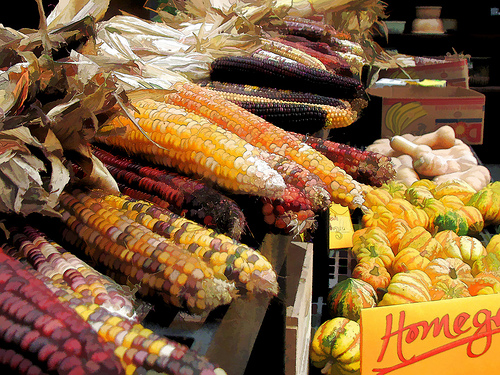Three Sisters Gardening
The three sisters are not siblings at all. It refers to the three mainstays of the Native American diet – corn, beans and squash – known as the sustainers of life.
These crops are seen as three beautiful sisters, because they grow in the same mound in a garden. The corn provides a ladder for the bean vine. The squash vines shade the mound and hold moisture in the soil for the corn and beans. The well-being of each crop planted is said to be protected by the other. As legend has it, the three should be planted together, eaten together, and celebrated together. And, as legends go, they vary from tribe to tribe. One such legend goes like this:
The legend of “Three Sisters” originated when a woman of medicine who could no longer bear the fighting among her three daughters asked the Creator to help her find a way to get them to stop. That night she had a dream, and in it each sister was a different seed. In her dream, she planted them in one mound in just the way they would have lived at home and told them that in order to grow and thrive; they would need to be different but dependent upon each other. They needed to see that each was special and each had great things to offer on her own and with the others. The next morning while cooking breakfast, she cooked each daughter an egg, but each was different: one hard-boiled, one scrambled, and one over-easy. She told her daughters of her dream and said to them,
“You are like these eggs. Each is still an egg but with different textures and flavors. Each of you has a special place in the world and in my heart.” The daughters started to cry and hugged each other, because now they would celebrate their differences and love one another more because of them. From that day on, Native people have planted the three crops together—Three Sisters helping and loving each other.
Native Americans planted this way for centuries without the modern vocabulary we use today, like soil nitrogen, vitamins, etc. They often looked for signs that indicated the right soil temperature and weather for planting corn – when the Canada geese return or the dogwood leaves reach the size of a squirrel’s ear it was time to plant.
Early European settlers would certainly never have survived without the gift of the Three Sisters from the Native Americans, the story behind our Thanksgiving celebration. Celebrating the importance of these gifts, not only to the Pilgrims but also to civilizations around the globe that readily adopted these New World crops, adds meaning to modern garden practices
Success with a Three Sisters garden involves careful attention to timing, seed spacing, and varieties. In many areas, if you simply plant all three in the same hole at the same time, the result will be a snarl of vines in which the corn gets overwhelmed!
Corn, squash, and beans: three seeds of change that have forever altered the world. These plants were important in the time of Native Americans and are equally as important now. To plant your own Three Sisters garden follow the directions below.
Instructions for Planting Your Own Three Sisters Garden in a 10 x 10 square
When to plant:
Sow seeds any time after spring night temperatures are in the 50 degree range, up through June.
What to plant:
Corn must be planted in several rows rather than one long row to ensure adequate pollination. Choose pole beans or runner beans and a squash or pumpkin variety with trailing vines, rather than a compact bush.
Note: A 10 x 10 foot square of space for your Three Sisters garden is the minimum area needed to ensure good corn pollination. If you have a small garden, you can plant fewer mounds, but be aware that you may not get good full corn ears as a result.
How to plant:
Refer to the diagrams below and to individual seed packets for additional growing information.
1. Choose a site in full sun (minimum 6-8 hours/day of direct sunlight throughout the growing season). Amend the soil with plenty of compost or aged manure, since corn is a heavy feeder and the nitrogen from your beans will not be available to the corn during the first year. With string, mark off three ten-foot rows, five feet apart.
2. In each row, make your corn/bean mounds. The center of each mound should be 5 feet apart from the center of the next. Each mound should be 18-inches across with flattened tops. The mounds should be staggered in adjacent rows. See Diagram #1
3. Plant 4 corn seeds in each mound in a 6-inch square. See Diagram #2
4. When the corn is 4 inches tall, its time to plant the beans and squash. First, weed the entire patch. Then plant 4 bean seeds in each corn mound. They should be 3-inches apart from the corn plants, completing the square as shown in Diagram #3.
5. Build your squash mounds in each row between each corn/bean mound. Make them the same size as the corn/bean mounds. Plant 3 squash seeds, 4-inches apart in a triangle in the middle of each mound as shown in Diagram #4.
6. When the squash seedlings emerge, thin them to 2 plants per mound. You may have to weed the area several times until the squash take over and shade new weeds.


Recent comments
Aenean nonummy hendrerit mauris. Phasellus porta.